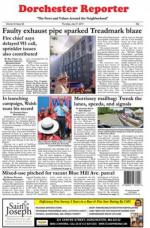September 10, 2008
A presentation on a study of Franklin Park's transportation patterns that will inform recommendations for changes went largely unnoticed last month, due to short notice to the Franklin Park Coalition and what appears to be an absence of advertising for the meeting. Only five people showed up to the Aug. 14 meeting hosted by the Boston Parks Department, and the director of the FPC, Christine Poff, wasn't one of them.
"I think it's disappointing that the study [presentation] is going on in the middle of the summer," said Poff, adding that she and many others did not have time to rearrange their schedules. "It would be better if it was in the fall."
Parks Department spokeswoman Margaret Dyson said the thinking behind the scheduling included a goal to get to the draft recommendations stage before November and the holidays, but said she'd make sure notices will go out well before future meetings, and is considering extending the comment period that officially ended Sept. 5.
The study could be a prelude to significant future changes in how the park is designed for people walking, running, riding and driving into, out of and through it, although no funding for such changes has yet been identified. Traffic counts, MBTA use, and a look at park entrances were among the items studied, as well as a review of recommendations from a 1991 study and the history of the park Frederick Law Olmsted designed in the late 19th Century as a pendant in his Emerald Necklace park system.
A few of the major points already evident from the study are that many of the park's entrances are uninviting - as are the roads one must cross to get to them - and in some cases they are inaccessible for those with disabilities. Helpful signage is also sorely lacking and many cars are speeding down Circuit Drive, the cut through that begins at Columbia Road and lets out on Jamaica Plain's Arborway.
"I definitely agree with one of the main points, that the signage and access points to the park are not well-marked," said Andrew Schroeder of DotBike, one of the five who saw the presentation. "Some of the access to the park is pretty poor at the moment."
The study points to a need to separate bike traffic from pedestrians, and also hints at narrowing of Circuit Drive to calm traffic.
In past years some have advocated to close Circuit Drive on Sundays, but those efforts ran in to red tape and have since stalled, according to Poff.
Martha Karchere, an FPC board member who attended the presentation, said that while she is happy the study is happening, its process has so far avoided some things she sees as critical community concerns.
"I can certainly understand them not wanting to touch a political hot potato, but they should certainly bookmark it," said Karchere. "I don't get the sense that they are doing that."
One example Karchere gives is a longstanding debate about vehicles from the maintenance yard and golf carts utilizing two historic stone bridges over Scarboro Pond on the south side of the park. The study recorded 150 vehicles headed over one of the bridges that leads to the maintenance yard from Shattuck Hospital - yet put that data in a strange context by comparing the rate of traffic to that of Blue Hill Avenue, Seaver Street and Circuit Drive in a bar graph.
Golf cart traffic on the smaller bridge, which often hosts conflicts between walkers and cart drivers, was not included at all.
When Karchere's fellow board member Lanae Handy requested that that traffic be looked at, and that people of color using the Walking Loop in the Southeast corner of the park be surveyed, the consultant emailed back to say that resources were limited and the additional data collection wouldn't be possible.
Yet the Walking Loop, Circuit Drive and the maintenance yard access will be focus areas for the recommendations, according to the presentation itself (available at franklinparkcoalition.org). Twelve geographic areas in all will be addressed, also including a look at parking in the White Stadium area, access to the Tennis Courts, and the bus stops around Shattuck Hospital.
A public meeting presenting the draft recommendations will likely be held in October, said Dyson.
Tags:



